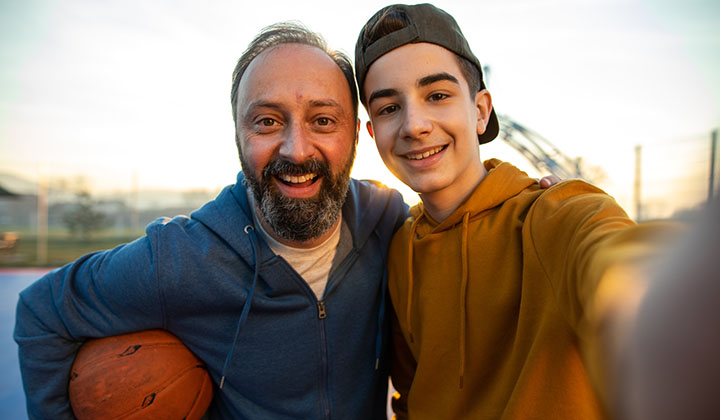Communicating about suicide, and what to do if you're a concerned parent

Trigger warning: This article contains information about suicide prevention that could be difficult for some readers. If you or someone you care about is struggling with thoughts of suicide, please reach out and get help by calling The National Suicide Prevention Lifeline at 988.
The thought of losing your child is one many caregivers try to avoid. And yet, suicide is the second leading cause of death for teens across the nation and in Kansas City. We want to help change this trend. Here are some ways to start.
Is it safe to talk about suicide?
Many parents worry it is not safe to ask about thoughts of suicide. It is common parents worry that asking about thoughts of suicide may give kids ideas. The research on this is clear. It IS safe to ask and does not increase risk. It increases the chance that the young person gets help. And it’s important to ask, as research tells us that as many as half of parents of youth who have been suicidal are not aware.
How do I start the conversation?
Parents may want to ask questions but don’t know where to begin. We think it’s really important for you to bring up a conversation about suicide with your child, even if it feels uncomfortable or scary. That’s normal! We encourage parents not to hesitate to talk about these tough issues. There are some great websites to help with what questions to ask. The Columbia Lighthouse Project website has a training to learn how to ask questions about suicide. The main focus is to ask about thoughts of not wanting to be alive, plans to end one’s life and any attempts they may have had.
Some examples are:
- Have you wished you were dead or wished you could go to sleep and not wake up?
- Have you been thinking about how you might do this?
- Do you intend to carry out this plan?
If you identify risk, you MUST do something about it. Don’t leave your child alone if they identify a plan for suicide. You may struggle to know what to say. It is always appropriate to thank your child for telling you, and to reassure them you will seek help. It is normal to feel overwhelmed as a caregiver in this situation. Reach out to a doctor, a friend, your partner, but make sure to get support for yourself as well.
What are the warning signs?
Sometimes, people notice changes in their child and don’t know what to say, or what to do. Even if it’s not your own child, it’s important for all adults in our community to feel a responsibility for our kids. It may not be your child who is struggling, but one of their friends or classmates. Sharing your concerns with that child’s parents is a start, even if it’s uncomfortable, it may help bring awareness to the changes or uncover an issue. Many people do show warning signs if they are considering suicide, and you might be the one to notice concerns.
Common warning signs can include one or more of the following:
- Becoming withdrawn from typical friend groups, family or activities
- Poor grooming
- Changes in appetite
- Failing grades
- Loss
- Conflict with friends and/or family
- Has been a victim of bullying or abuse
- Frequent stomach and/or head complaints
- Struggles with their gender identity or sexual identity
- Being exposed to suicide behaviors from friends, family or media
- Reckless behavior
- Substance abuse
- Self-injury and/or a previous suicide attempt
Safe storage is key
While it may be difficult to think about, there are ways to make your home safer and decrease the risk of suicide in your home. Studies tell us that limiting access to the objects that are used in suicide is one of the best ways to do this. Restricting access is an ongoing effort that assures your home environment remains as safe as possible.
Firearms:
- Store firearms outside the home, if possible.
- For firearms stored in the home, the safest approach is making sure firearms are stored locked up, unloaded, with the ammunition locked up separately. Free gun locks, with no questions asked, are available at Children’s Mercy security desks and many clinics are handing them out as well.
Medication:
- We recommend keeping only a small amount of medication unlocked in a pill organizer and locking the rest up in a safe and secure place such as a locked cabinet, drawer or box. Dispose of any leftover medications to reduce the risk of accidental exposure or misuse. Remember that all medications, even those that do not require a prescription, should be stored securely. Learn more from our experts on proper medication storage and disposal practices.
Supervision:
- Part of a strong safety plan is making sure to increase adult supervision for young people at risk for suicide. Some parents do a “room sweep” to check for items that could be used in suicide. If you see something odd that doesn’t make sense, do not hesitate to ask about it.
Here are some things you can do, if you feel someone you know is at risk of harming themselves:
- Call 911 or take them to the nearest hospital emergency room for further evaluation.
- Call the National Suicide Prevention Lifeline: 988.
- Text “HOME” to 741741 to connect to a crisis counselor 24/7.
- Find more information about mental health on our website.
Reason to Hope
Thoughts of suicide are a concern to be taken seriously. We also know the majority of people who have thoughts of suicide do not die by suicide. We have steps we can take as a community to reduce risk for our youth.

